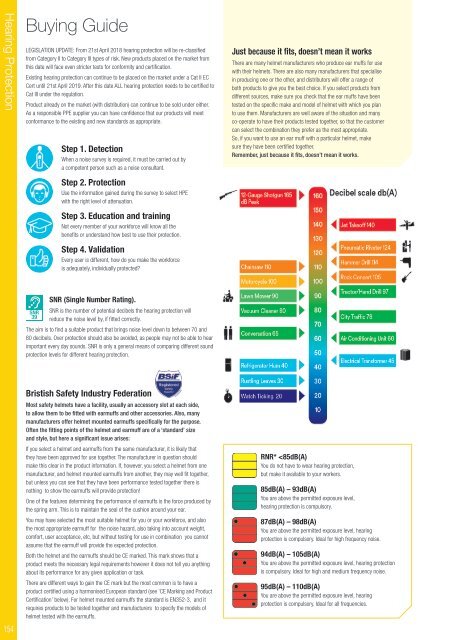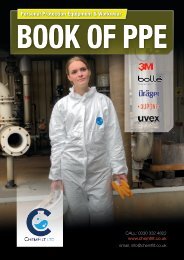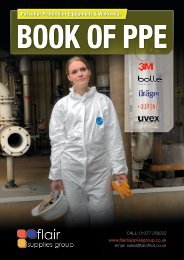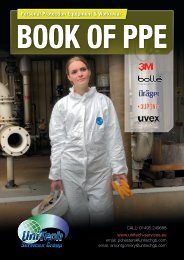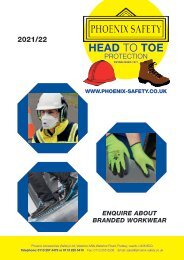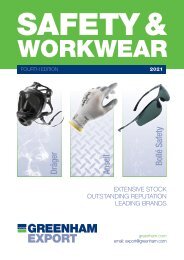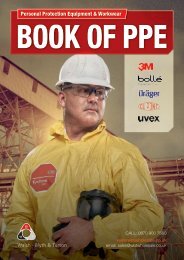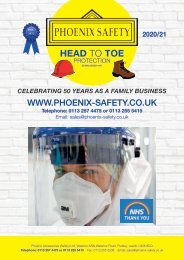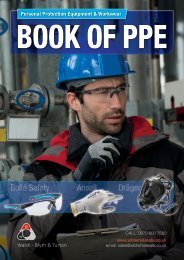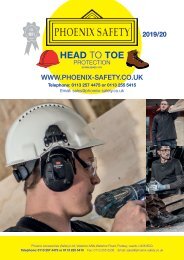Create successful ePaper yourself
Turn your PDF publications into a flip-book with our unique Google optimized e-Paper software.
Hearing Protection<br />
Buying Guide<br />
LEGISLATION UPDATE: From 21st April <strong>2018</strong> hearing protection will be re-classified<br />
from Category II to Category III types of risk. New products placed on the market from<br />
this date will face even stricter tests for conformity and certification.<br />
Existing hearing protection can continue to be placed on the market under a Cat II EC<br />
Cert until 21st April <strong>2019</strong>. After this date ALL hearing protection needs to be certified to<br />
Cat III under the regulation.<br />
Product already on the market (with distribution) can continue to be sold under either.<br />
As a responsible <strong>PPE</strong> supplier you can have confidence that our products will meet<br />
conformance to the existing and new standards as appropriate.<br />
Step 1. Detection<br />
When a noise survey is required, it must be carried out by<br />
a competent person such as a noise consultant.<br />
Step 2. Protection<br />
Use the information gained during the survey to select HPE<br />
with the right level of attenuation.<br />
Step 3. Education and training<br />
Not every member of your workforce will know all the<br />
benefits or understand how best to use their protection.<br />
Step 4. Validation<br />
Every user is different, how do you make the workforce<br />
is adequately, individually protected?<br />
Just because it fits, doesn’t mean it works<br />
There are many helmet manufacturers who produce ear muffs for use<br />
with their helmets. There are also many manufacturers that specialise<br />
in producing one or the other, and distributors will offer a range of<br />
both products to give you the best choice. If you select products from<br />
different sources, make sure you check that the ear muffs have been<br />
tested on the specific make and model of helmet with which you plan<br />
to use them. Manufacturers are well aware of the situation and many<br />
co-operate to have their products tested together, so that the customer<br />
can select the combination they prefer as the most appropriate.<br />
So, if you want to use an ear muff with a particular helmet, make<br />
sure they have been certified together.<br />
Remember, just because it fits, doesn’t mean it works.<br />
SNR<br />
39<br />
SNR (Single Number Rating).<br />
SNR is the number of potential decibels the hearing protection will<br />
reduce the noise level by, if fitted correctly.<br />
The aim is to find a suitable product that brings noise level down to between 70 and<br />
80 decibels. Over protection should also be avoided, as people may not be able to hear<br />
important every day sounds. SNR is only a general means of comparing different sound<br />
protection levels for different hearing protection.<br />
154<br />
Bristish Safety Industry Federation<br />
Most safety helmets have a facility, usually an accessory slot at each side,<br />
to allow them to be fitted with earmuffs and other accessories. Also, many<br />
manufacturers offer helmet mounted earmuffs specifically for the purpose.<br />
Often the fitting points of the helmet and earmuff are of a ‘standard’ size<br />
and style, but here a significant issue arises:<br />
If you select a helmet and earmuffs from the same manufacturer, it is likely that<br />
they have been approved for use together. The manufacturer in question should<br />
make this clear in the product information. If, however, you select a helmet from one<br />
manufacturer, and helmet mounted earmuffs from another, they may well fit together,<br />
but unless you can see that they have been performance tested together there is<br />
nothing to show the earmuffs will provide protection!<br />
One of the features determining the performance of earmuffs is the force produced by<br />
the spring arm. This is to maintain the seal of the cushion around your ear.<br />
You may have selected the most suitable helmet for you or your workforce, and also<br />
the most appropriate earmuff for the noise hazard, also taking into account weight,<br />
comfort, user acceptance, etc, but without testing for use in combination you cannot<br />
assume that the earmuff will provide the expected protection.<br />
Both the helmet and the earmuffs should be CE marked. This mark shows that a<br />
product meets the necessary legal requirements however it does not tell you anything<br />
about its performance for any given application or task.<br />
There are different ways to gain the CE mark but the most common is to have a<br />
product certified using a harmonised European standard (see ‘CE Marking and Product<br />
Certification’ below). For helmet mounted earmuffs the standard is EN352‐3, and it<br />
requires products to be tested together and manufacturers to specify the models of<br />
helmet tested with the earmuffs.<br />
RNR*


